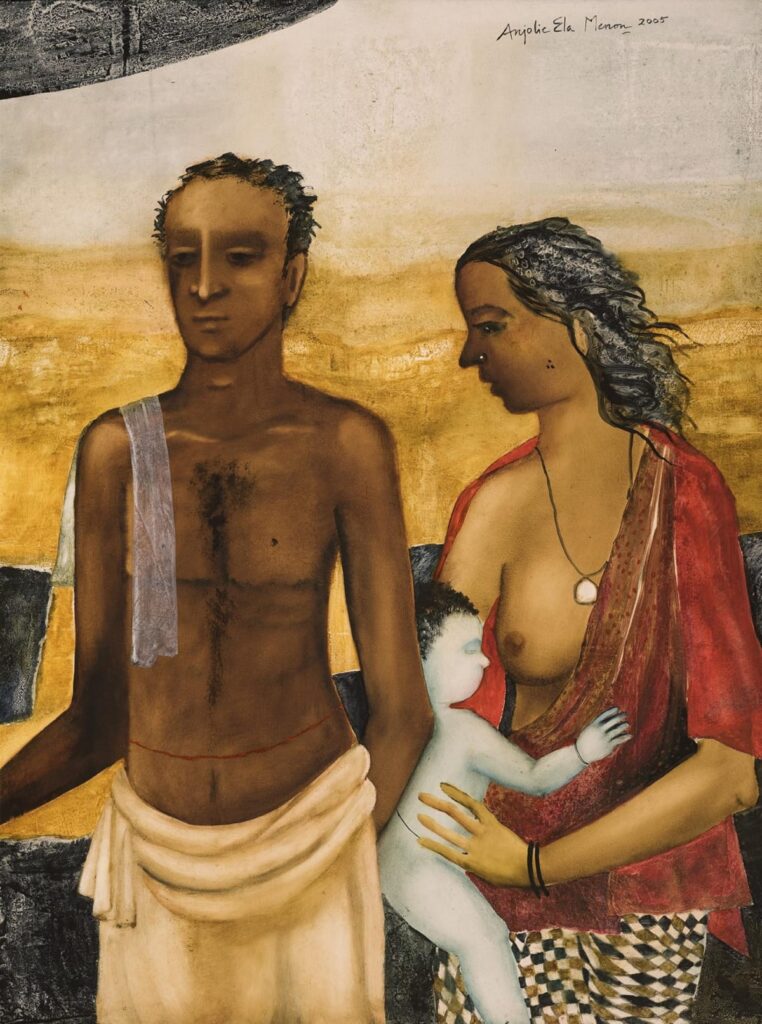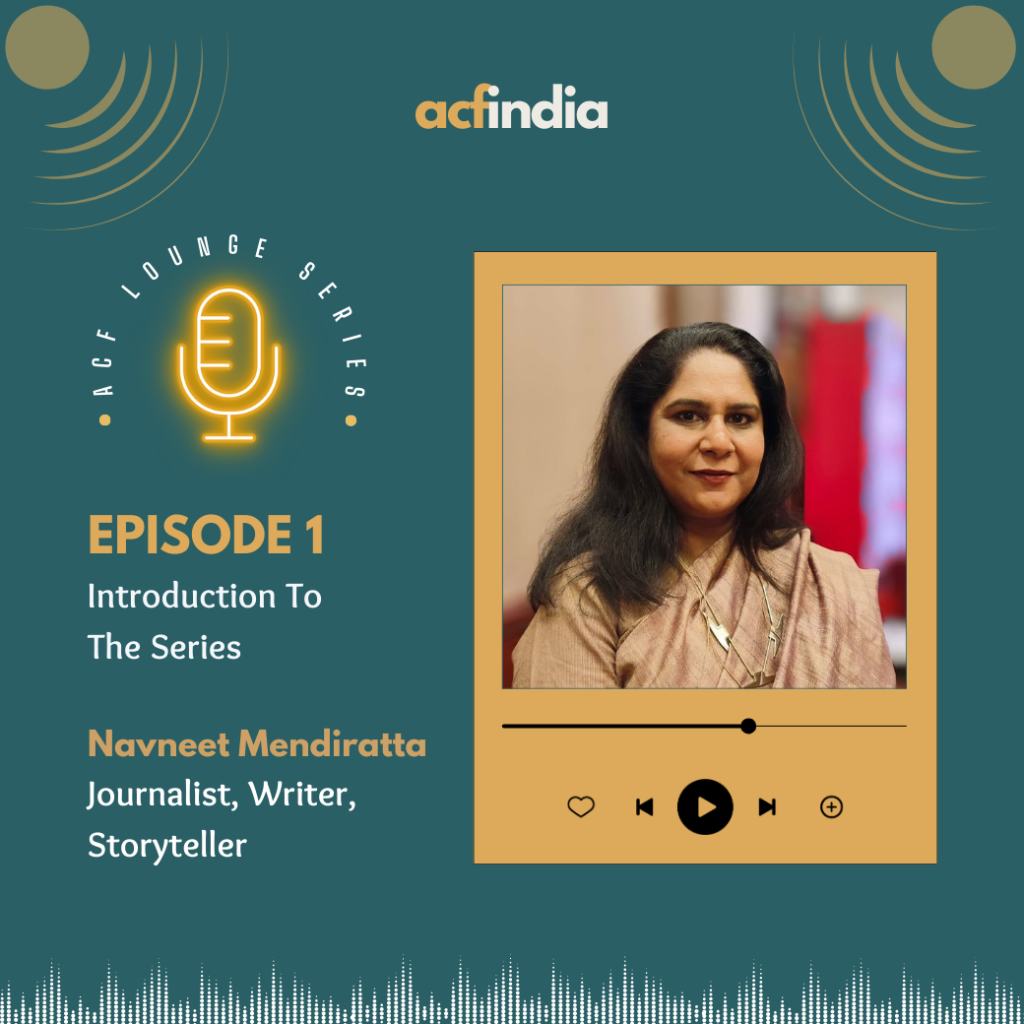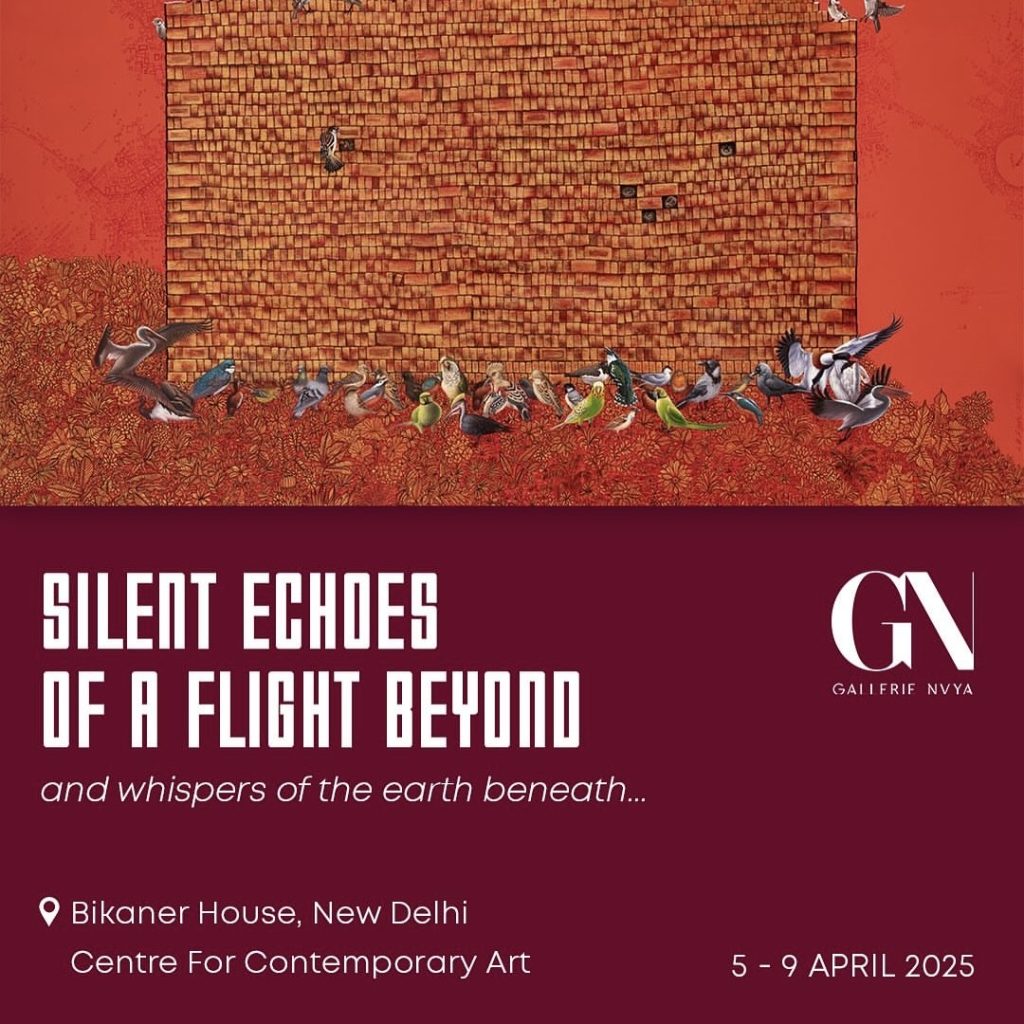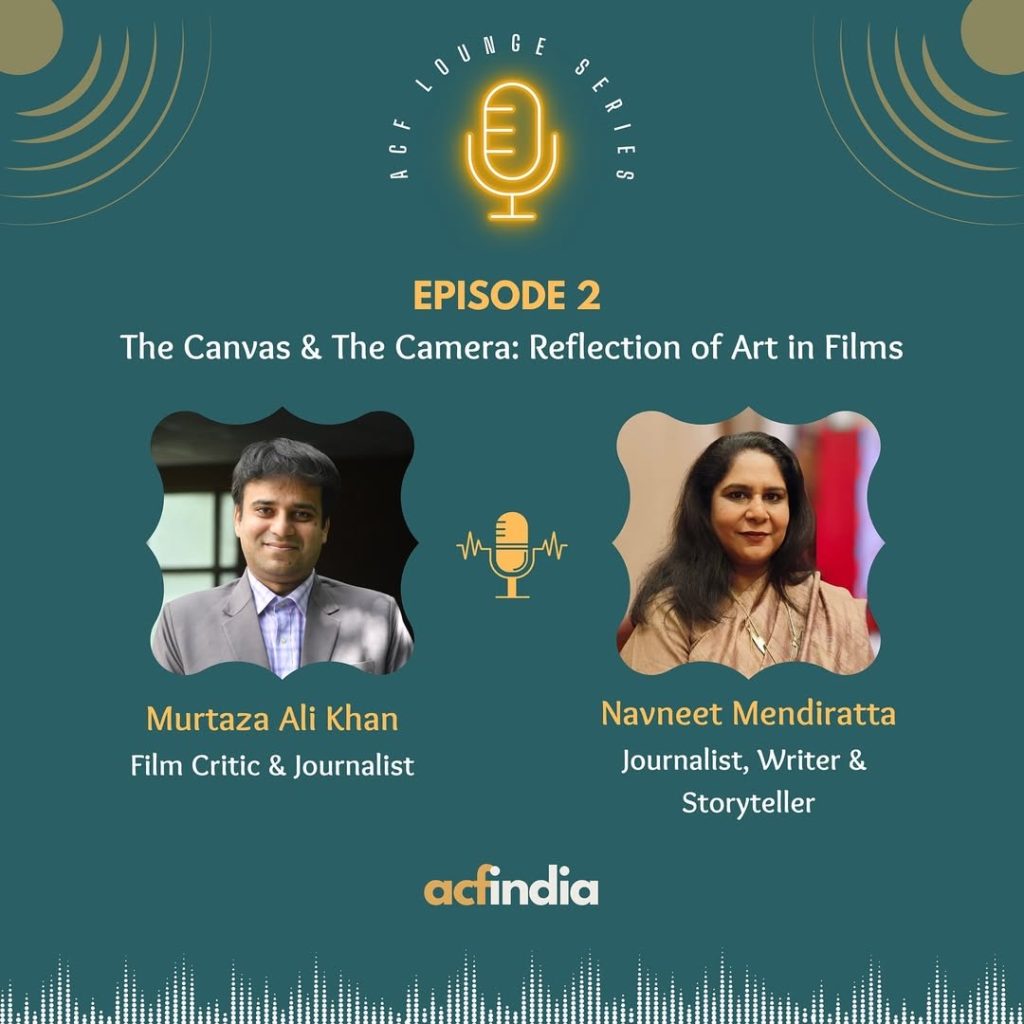By Bhavya Balamurali
Born in the 19th century’s colonial era, Contemporary Indian art is a tapestry of heritage and change. From Bengal school’s revivalist spirit to Ambika Dhurandhar, Amrita Sher-Gil and Meera Mukherjee’s mastery in mythical vision, contemporary Indian art is a dialogue between tradition and modernity. Eventually shedding its colonial shadow and embracing bold expressions, with Shantiniketan’s pastoral charm and Mughal influence, Indian contemporary art shaped its own visual language.
In the 20th century, women started redefining modern art, not as muses but as visionaries, carrying with them the weight of untold experiences and ancestral memory. Through bold strokes and evocative style women made their marks in the world of contemporary Indian art. India now has some of the most celebrated artists in the world, who transformed the margins and put forth the voices of the unheard and unseen.
ANJU DODIYA
Image Credit; Anju Dodiya/ JNAF.ORG
A graduate of JJ School of Art, Anju Dodiya is a leading figure in Indian contemporary art. Emerging from the early 1990’s Mumbai art scene, she belongs to the generation of artists who redefined Indian contemporary art. With her art expressing inner dialogue through layered visual experiences, Dodiya is known for her evocative and introspective style, unravelling stories through her contemporary work. Through fictionalized self-portraits and mythical female protagonist, her work unravels human complexities, inner self, memory, and creation itself.
Image Credit: The Reader, Anju Dodiya/ AD
Blurring the lines between personal self and universal emotion, her work is poetic with her visual language being intimate, theatrical and at the same time deeply human. drawing influence from Italian renaissance masters, Japanese Ukiyo-e print, cinema and poetry, her work has its own distinct figurative language.
As one of India’s most compelling contemporary artists, Anju Dodiya carved a universally resonant art landscape. Her work reminds us that the act of making ar,t is as much about wrestling inner storms as it is about creating beauty.
ANJOLIE ELA MENON
Image Credit: Anjolie Ela Menon/ Dagworld
Anjolie Ela Menon is Padma Shri awardee and India’s most celebrated Contemporary artist. Her work reshaped the landscape of Modern Indian Art, through narrative driven and human centric art. Menon through her distinctive style, combines classical technique with deeply personal and symbolic narrative.
Intimate portraits of melancholic women, weathered windows, empty chairs and crow populate her canvas, making Menon’s work instantly recognizable. With an unapologetically figurative style, her work is timeless and emotionally charged. The use of muted, earthy pallet and textured surface, her art is deeply layered, drawing inspiration from Byzantine iconography, medieval Christian art and Indian folk traditions. Her art is metaphorical with elements like birds, unspoken gestures and architectural elements, resonating across generations. Menon’s work is exhibited globally and continues to inspire young artist.
Image Credit: Upanayanam, Anjolie Ela Menon/ DNA India
In this hyper digital world, Menon’s work resonates the enduring power of intimate, hand painted storytelling. Her art creates a space where not just memory, myth and everyday meets but also captures people and the silence between them.
ARPANA CAUR
Image Credit: Arpana Caur / theartofindia
As a pioneering voice in the dynamic world of Indian contemporary art, Arpana Caur’s art is driven by the inborn urge to create. Emerging in 1970’s, Caur defied convention and expectation during a time when Delhi’s art space was sparse. Daughter of celebrated writer Ajeet Caur, Arpana captured the complexities of India’s socio-political landscape through her art.
Arpana’s artistic expressions captured the trauma of Sikh massacre to the relentless urbanization of Delhi through layered symbolism and spiritual undertone. Her visual language blends inspiration forms Indian miniature paintings, indigenous folk art and Pahari painting, making it both rooted and radical. Her subjects were not convention, with themes like women’s experiences, ecological anxieties and existential musing. She was the first Indian contemporary artist to collaborate with indigenous voices within the modern art world.
Image Credit: End of Night, Arpana Caur/ mutualart
Arpana Caur’s works are exhibited among prestigious collections worldwide. With an indelible niche for herself, she is an artist that captures the soul of Indian artistry in her contemporary work, whose legacy continues to inspire.
NALANI MALANI
Image Credit: Nalani Malani/ JNAF
Born in 1946 in Karachi, Nalani Malani carved a space uniquely her own in the ever-evolving world of contemporary Indian art. Her experience with partition quietly weaves into the narrative she tells through her art.
She has a different approach towards art. With her early works of experimental films and video art, she was set apart from the traditional art scene. Her distinctive expression through installations, shadow play and animation are visual poems on displacement, violence and forgotten history. Malani’s work involves reimagined female figures from mythology, with protagonists like ‘Madea’ and ‘Sita’, who were silenced in ancient tales, finding their voices through her art. Her art makes these characters rise again and comment on present day injustices, gender politics and cyclical nature of violence.
Image Credit: Nalani Malani’s display at Tate Modern/ tate.org.uk
Today even as she experiments with digital platforms, her art’s purpose remains the same. From being one of the earliest champions of female-led exhibitions in India to having her work exhibited in prestigious spaces like Tate Modern and Central Pompidou, her art echoes local stories that questions, challenges and remembers.
ANITA DUBE
Image Credit: Anita Dube/ Khoj Studio
Born in 1958, Anita Dube’s art represents everything contemporary, from themes to mediums. Quietly reshaping conversations around power, memory and resistance, Dube is a trained historian and art critic. Her work echoes unmatched intellectual rigour, coupling aesthetic sensibility with social consciousness.
Anita Dube’s work cannot be contained with conventions. Finding her medium in the overlooked, like industrial foam, ritualistic objects, handwritten letters and prosthetic body parts, her work is charged with history, trauma and tenderness. Dube’s work can be described as a tactile archive on India’s collective and personal wounds. From invoking mythological female figures to crafting installations that confront caste, patriarchy and oppression, her art is political, feminist and unafraid, challenging viewers to reckon with the uncomfortable truth.
Image Credit: Spread the Love, Anita Dube/ Ocula
Her curatorship of the 2018 Kochi-Muziris Biennale was the first ever led by a woman, as a landmark moment she transformed the exhibition into a space of dialogues and dissent. As one of the most significant artists of today’s time her practice is rotted in text as a vessel of ideology, retrieved from poems, graffiti and manifestos, reframing them into symbols of sacredness and revolution.
JAYASRI BURMAN
Image Credit: Jayasri Burman/ zeolineartgallery
Born in 1960 in Kolkata, Jayasri Burman started painting at a young age under the guidance of her father, renowned artist Biren Roy. With extraordinary imagination and lyrical visual storytelling, Burman carved a niche for herself in the world of Indian contemporary art. Based in New Delhi, she spent over four decades in the field of contemporary art weaving an intricate world where folklore, nature and divinity coexist.
Mythological goddesses, nature’s bounty and beasts cover her canvases in vivid hues and delicate detailing. Her work is a seamless fusion of India’s rich folk tradition within the contemporary sensibilities, evoking the warmth of childhood tales, ancient rituals while speaking profoundly to the modern viewer. Jayasri’s work is an experience of resilience, heritage and the enduring power of myth in contemporary art.
Image Credit: Untitled, Jayasri Burman/ Alchetron
With her work being displayed around the world, it is celebrated for their bold lines, emotive storytelling and fluid form. In 2007, Burman was honoured by the Indian government with a series of commemorative stamps, which is a rare recognition of an artist’s cultural imprint. Through her art, she reimagines India’s artistic legacy for a new generation reaffirming her place in the world of contemporary art.
SHILPA GUPTA
Image Credit: Shilpa Gupta/ Vervemagazine
Shilpa Gupta stands as a powerful, fearless voice redefining the experience of art and what it means to be an artist in this complex world. Born in Mumbai in 1976, Gupta emerged as one of India’s most internationally acclaimed contemporary artists.
Shilpa Gupta’s art incorporates ordinary material like microphone, soap bars, sound and light into layered conversations about censorship, nationalism, social conformity and nationalism. Her work sweeps into public spheres, the internet and even in politically charged borders, making her one of the artists whose work resonates with the struggles of the world. Gupta’s artistic practices are bold interrogations of identity, belief system and the collective experience, aimed at creating dialogues. Her work continues to challenge, provoke and inspire generations to reimagine.
Image Credit: Singing Cloud, Shilpa Gupta/ Pinterest
Shilpa Gupta’s influence in the contemporary world is undeniable. Whether through poems written by imprisoned poets or installations that confront the lingering wound of partition, she sheds light on the suppressed history and gives voice to the silenced. From participating in events like Kochi Muziris Biennale and the Venice Biennale to solo exhibitions at Tate Modern and Barbican, she is one of the most important figures in the world of contemporary art, reimagining the purpose of art in society through her work.












